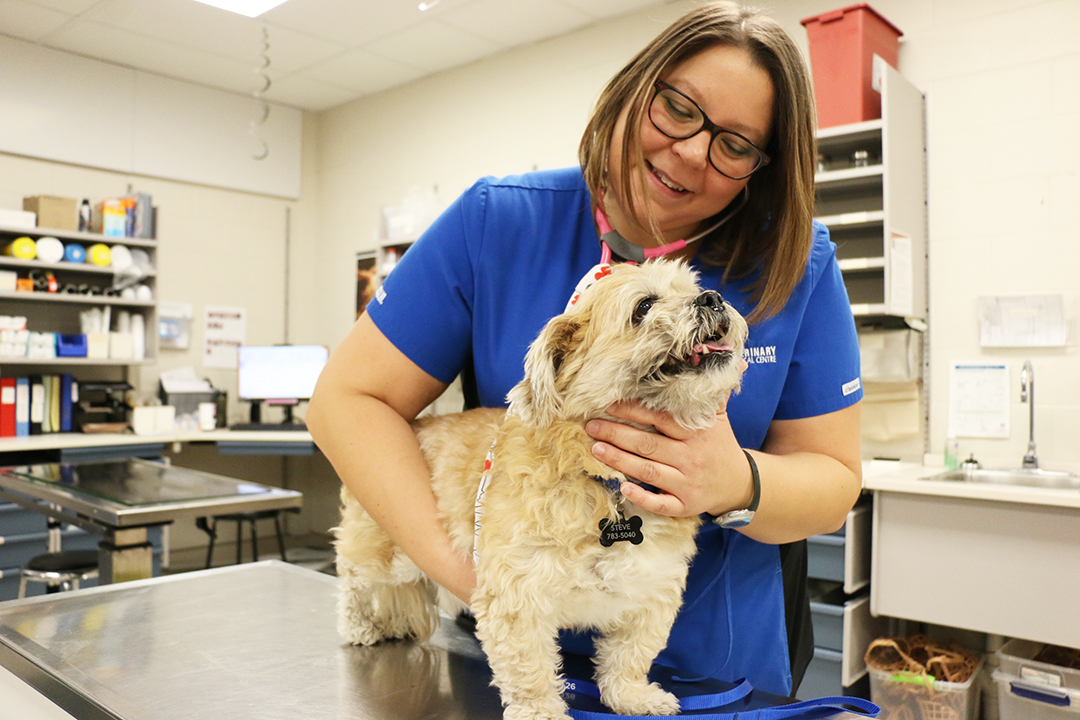
RVT Month highlights ‘behind-the-scenes’ profession
Registered veterinary technologists or technicians (RVTs) have been an integral part of animal health care for over 50 years, but their profession is still a mystery for many people.
By Taryn RiemerThat’s one big reason why the Registered Veterinary Technologists and Technicians of Canada (RVTTC) began designating October as “RVT Month” across Canada. This annual celebration helps to promote and recognize RVTs, plus it creates more public awareness about the many roles and possibilities that exist in the career.
Danielle Mierau is an RVT and lead hand at the Western College of Veterinary Medicine’s (WCVM) Veterinary Medical Centre (VMC). As she explains, RVTs are the behind-the-scenes people who work closely with their patients and do much of the hands-on care.
“RVTs are the patient advocates. That's why I wanted to be an RVT because I wanted to work with patients,” says Mierau. “I get to spend time with the patients — nursing them, getting to know them, caring for them, making sure they're pain-free and doing whatever we can for them.”
While many people equate RVTs to nurses or technicians in the human health care field, Mierau points out that RVTs are trained to fulfil a much wider variety of responsibilities — everything from monitoring anesthetized patients and conducting electrocardiogram tests to taking X-rays and performing surgeries under the guidance of a veterinarian.
“There are many different facets of our job. And here at the college, we’re fortunate enough that we can specialize in different areas,” says Mierau, who has specialized training in emergency and critical care.
RVTs cover about 75 positions in the WCVM’s veterinary teaching hospital as well as in its animal care unit and the veterinary college. The hospital’s clinical services such as oncology, ophthalmology, dentistry, medicine, emergency and critical care, surgery and anesthesia all require at least one RVT who is “our go-to tech for that service” explains Mierau.
Besides doing the clinical aspects of their jobs, many RVTs are also involved in teaching veterinary students in the college’s Doctor of Veterinary Medicine (DVM) program.
“While the veterinarians are teaching [the WCVM students] the case management and the theory, the RVTs on the floor are teaching them how to restrain the patient, how to put the catheter in, how to take the patient’s blood, how to intubate in anesthesia — all the practical, hands-on tasks they do every day,” says Nadine Schueller, RVT and the VMC’s manager of technical services.
RVTs who work at the veterinary college also help to teach students enrolled in the Saskatchewan Polytechnic’s two-year veterinary technology program. During their second year, these students attend lectures at the WCVM and spend eight weeks gaining hands-on skills and experience in clinical rotations at the VMC.
Danielle Groat graduated from the Saskatchewan Polytechnic’s veterinary technology program in June 2018 and now works at the WCVM’s teaching hospital.
“During my rotations, the WCVM seemed like a fun place to be. I liked the people and I saw that there was a radiology job and I loved radiology in school, so I thought that it would be a great opportunity to come right out of school and learn more in-depth knowledge about a certain area,” says Groat.
She enjoys working at the WCVM and teaching students has become one of the favourite parts of her job. “It was kind of overwhelming at first, but it's really great … being able to teach the vet students and to be able to feel like you've accomplished something by teaching them how to do it and just seeing them grow.”
Groat also says she likes how the annual “RVT Month” campaign in Canada has been successful in educating the public about the profession and demonstrating the many “hats” that RVTs wear in their daily work lives.
Schueller agrees, adding that’s why the event has grown from a “thank you for what you do” week to a month-long, national program that emphasizes public education, advocacy, the role of RVTs and their profession, and the value they bring to their patients and animal owners as well as their contributions to animal health care teams.
“The general public has no idea that there is this kind of person in the veterinary world. They see the veterinarian, but they don't see all the behind-the-scenes work,” says Schueller. “This month gets that message out there that ‘Hey — we're here, too.’”
During the week of Oct. 14-19, the WCVM Veterinary Medical Centre heightened awareness by organizing daily celebrations for the college’s RVT team — everything from candy bags in their mailboxes to cupcakes. Organizers also encouraged people to write thank you messages to RVTs on a large poster that was on display by the staff lunch room.
“There's so much unknown about our profession that this month is the opportunity to show the world,” says Schueller. She adds that the national event’s focus may eventually change, but the original concept of thanking RVTs for all they do will continue to be an important part of RVT Month.
“That little bit of appreciation is kind of nice for these guys.”